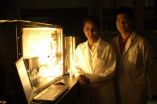(Press-News.org) The Orion Nebula, also known as Messier 42, is one of the most easily recognisable and best-studied celestial objects. It is a huge complex of gas and dust where massive stars are forming and is the closest such region to the Earth. The glowing gas is so bright that it can be seen with the unaided eye and is a fascinating sight through a telescope. Despite its familiarity and closeness there is still much to learn about this stellar nursery. It was only in 2007, for instance, that the nebula was shown to be closer to us than previously thought: 1350 light-years, rather than about 1500 light-years.
Astronomers have used the Wide Field Imager on the MPG/ESO 2.2-metre telescope at ESO's La Silla Observatory in Chile to observe the stars within Messier 42. They found that the faint red dwarfs in the star cluster associated with the glowing gas radiate much more light than had previously been thought, giving us further insights into this famous object and the stars that it hosts. The data collected for this science project, with no original intention to make a colour image, have now been reused to create the richly detailed picture of Messier 42 shown here.
The image is a composite of several exposures taken through a total of five different filters. Light that passed through a red filter as well as light from a filter that shows the glowing hydrogen gas, were coloured red. Light in the yellow–green part of the spectrum is coloured green, blue light is coloured blue and light that passed through an ultraviolet filter has been coloured purple. The exposure times were about 52 minutes through each filter.
This image was processed by ESO using the observational data found by Igor Chekalin (Russia), who participated in ESO's Hidden Treasures 2010 astrophotography competition, organised by ESO in October–November 2010, for everyone who enjoys making beautiful images of the night sky using real astronomical data.
Igor searched through ESO's archive and identified datasets that he used to compose his image of Messier 42, which was the seventh highest ranked entry in the competition, out of almost 100 entries. His original work can be seen here: http://www.flickr.com/photos/igorfp/5216868239/in/pool-1562202@N22/ . Igor Chekalin was awarded the first prize of the competition for his composition of Messier 78 (link to Flickr), and he also submitted an image of NGC3169, NGC3166 and SN 2003cg, which was ranked second highest.
ESO's Hidden Treasures 2010 competition gave amateur astronomers the opportunity to search through ESO's vast archives of astronomical data, hoping for a well-hidden gem that needed polishing by the entrants. Participants submitted nearly 100 entries and ten skilled people were awarded some extremely attractive prizes, including an all expenses paid trip for the overall winner to ESO's Very Large Telescope (VLT) on Cerro Paranal, in Chile, the world's most advanced optical telescope. The ten winners submitted a total of 20 images that were ranked as the highest entries in the competition out of the near 100 images.
INFORMATION:
More information
ESO, the European Southern Observatory, is the foremost intergovernmental astronomy organisation in Europe and the world's most productive astronomical observatory. It is supported by 15 countries: Austria, Belgium, Brazil, the Czech Republic, Denmark, France, Finland, Germany, Italy, the Netherlands, Portugal, Spain, Sweden, Switzerland and the United Kingdom. ESO carries out an ambitious programme focused on the design, construction and operation of powerful ground-based observing facilities enabling astronomers to make important scientific discoveries. ESO also plays a leading role in promoting and organising cooperation in astronomical research. ESO operates three unique world-class observing sites in Chile: La Silla, Paranal and Chajnantor. At Paranal, ESO operates the Very Large Telescope, the world's most advanced visible-light astronomical observatory and VISTA, the world's largest survey telescope. ESO is the European partner of a revolutionary astronomical telescope ALMA, the largest astronomical project in existence. ESO is currently planning a 42-metre European Extremely Large optical/near-infrared Telescope, the E-ELT, which will become "the world's biggest eye on the sky".
Links
- ESO's Hidden Treasures 2010 competition: http://www.eso.org/public/outreach/hiddentreasures/index.html
- Research papers:
http://adsabs.harvard.edu/abs/2009ApJS..183..261D
http://iopscience.iop.org/0004-637X/722/2/1092
- Photos of La Silla Observatory: http://www.eso.org/public/images/archive/category/lasilla/
Contacts
Richard Hook
ESO, La Silla, Paranal, E-ELT and Survey Telescopes Public Information Officer
Garching bei München, Germany
Tel: +49 89 3200 6655
Cell: +49 151 1537 3591
Email: rhook@eso.org
The Orion nebula: Still full of surprises
2011-01-20
ELSE PRESS RELEASES FROM THIS DATE:
Cancer scientists discover genetic diversity in leukemic propagating cells
2011-01-20
(Toronto, Canada – January 20, 2011) – Cancer scientists led by Dr. John Dick at the Ontario Cancer Institute (OCI) and collaborators at St Jude Children's Research Hospital (Memphis) have found that defective genes and the individual leukemia cells that carry them are organized in a more complex way than previously thought.
The findings, published today in Nature (DOI:10.1038/nature09733), challenge the conventional scientific view that cancer progresses as a linear series of genetic events and that all the cells in a tumour share the same genetic abnormalities and ...
How much sex is enough?
2011-01-20
Society has long debated the contrasting advantages of monogamy and promiscuity and, in western society at least, the long term benefits of monogamy have in general won out. However new research published in BioMed Central's open access journal BMC Evolutionary Biology shows that sperm from polygamous mice are better competitors in the race for fertilisation.
Dr Renée Firman at the Centre for Evolutionary Biology, University of Western Australia, has used house mice to show that sperm from rival males compete to fertilise females and that, over several generations, polygamy ...
Creating simplicity: How music fools the ear
2011-01-20
What makes music beautiful? The best compositions transcend culture and time – but what is the commonality which underscores their appeal? New research published in BioMed Central's open access journal BMC Research Notes suggests that the brain simplifies complex patterns, much in the same way that 'lossless' music compression formats reduce audio files, by removing redundant data and identifying patterns.
There is a long held theory that the subconscious mind can recognise patterns within complex data and that we are hardwired to find simple patterns pleasurable. Dr ...
Quality improvement intervention for ICUs results in increased use of evidence-based care practices
2011-01-20
A multifaceted quality improvement intervention that included education, reminders and feedback through a collaborative telecommunication network improved the adoption of evidenced-based care practices in intensive care units at community hospitals for practices such as preventing catheter-related bloodstream infections and ventilator-associated pneumonia, according to a study that will appear in the January 26 issue of JAMA. The study is being published early online to coincide with its presentation at the annual meeting of the Society of Critical Care Medicine.
Despite ...
Triblock spheres provide a simple path to complex structures
2011-01-20
CHAMPAIGN, Ill. — University of Illinois materials scientists have developed a simple, generalizable technique to fabricate complex structures that assemble themselves.
Their advance, published in the Jan. 20 issue of Nature, utilizes a new class of self-assembling materials that they developed. The team demonstrated that they can produce a large, complex structure – an intricate lattice – from tiny colloidal particles called triblock Janus spheres.
"This is a big step forward in showing how to make non-trivial, non-obvious structures from a very simple thing," said ...
Survey reveals potential innovation gap in the US
2011-01-20
Cambridge, Mass., January 19, 2011 – Invention and innovation are essential to remaining globally competitive, and a new survey shows an untapped group of potential inventors in the U.S. The 2011 Lemelson-MIT Invention Index , announced today, indicates that American women ages 16 – 25 possess many characteristics necessary to become inventors, such as creativity, interest in science and math, desire to develop altruistic inventions, and preference for working in groups or with mentors – yet they still do not see themselves as inventive. Young men in the same age group ...
Parental divorce linked to suicidal thoughts
2011-01-20
TORONTO, ON –Adult children of divorce are more likely to have seriously considered suicide than their peers from intact families, suggests new research from the University of Toronto
In a paper published online this week in the journal Psychiatry Research, investigators examined gender specific differences among a sample of 6,647 adults, of whom 695 had experienced parental divorce before the age of 18. The study found that men from divorced families had more than three times the odds of suicidal ideation in comparison to men whose parents had not divorced. Adult daughters ...
Case Western Reserve and Athersys show regenerative benefit of MultiStem after spinal cord injury
2011-01-20
Case Western Reserve University School of Medicine and Athersys, Inc. (NASDAQ: ATHX) announced a joint scientific study on spinal cord injury will be published today in the January issue of the Journal of Neuroscience. The study, by leading researchers from the Department of Neurosciences at the School of Medicine and scientists at Athersys, presents data supporting the potential therapeutic benefit of Athersys' MultiStem® program for spinal cord injury. Researchers observed that administration of Multipotent Adult Progenitor Cells (MAPC) following spinal cord injury in ...
New reactor paves the way for efficiently producing fuel from sunlight
2011-01-20
PASADENA, Calif.—Using a common metal most famously found in self-cleaning ovens, Sossina Haile hopes to change our energy future. The metal is cerium oxide—or ceria—and it is the centerpiece of a promising new technology developed by Haile and her colleagues that concentrates solar energy and uses it to efficiently convert carbon dioxide and water into fuels.
Solar energy has long been touted as the solution to our energy woes, but while it is plentiful and free, it can't be bottled up and transported from sunny locations to the drearier—but more energy-hungry—parts ...
Malaria parasite caught red-handed invading blood cells
2011-01-20
Australian scientists using new image and cell technologies have for the first time caught malaria parasites in the act of invading red blood cells. The researchers, from the Walter and Eliza Hall Institute in Melbourne, Australia, and the University of Technology, Sydney (UTS), achieved this long-held aim using a combination of electron, light and super resolution microscopy, a technology platform new to Australia.
The detailed look at what occurs as the parasite burrows through the walls of red blood cells provides new insights into the molecular and cellular events ...




